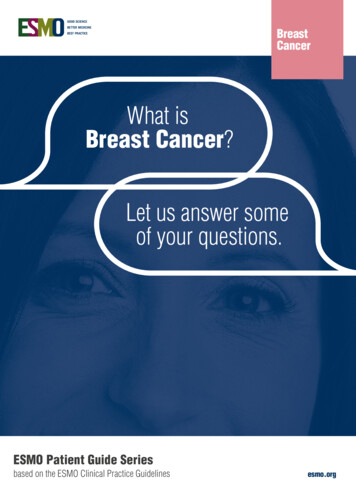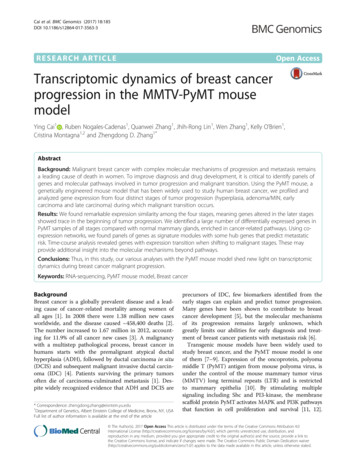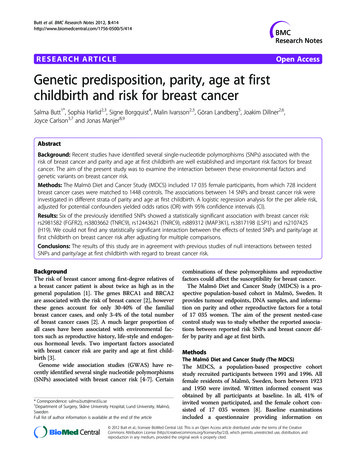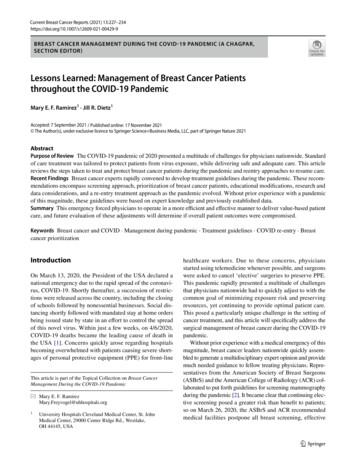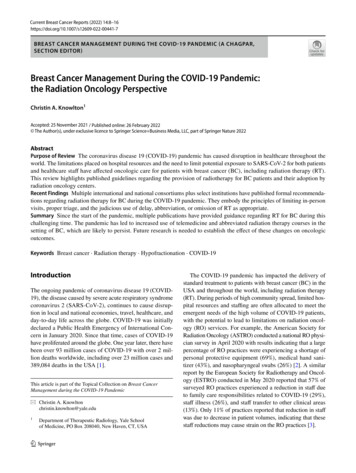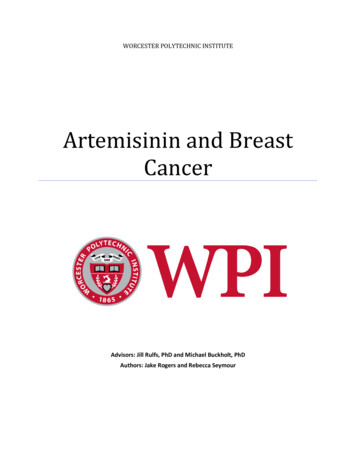
Transcription
WORCESTER POLYTECHNIC INSTITUTEArtemisinin and BreastCancerAdvisors: Jill Rulfs, PhD and Michael Buckholt, PhDAuthors: Jake Rogers and Rebecca Seymour
Table of ContentsAbstract . 3Acknowledgements. 4Background . 5Breast Cancer and Current Forms of Treatment . 5Types of Breast Cancer . 5Hormone Therapy . 6Treatment . 8Side Effects . 8Model Cell System . 9Discovery of the MCF-7 Cell Line . 9Estrogen . 10Estrogen Receptor-α . 10Estrogen Receptor-β . 11History and Effects of Artemisia annua/ Artemisinin . 11Artemisia Annua and Artemisinin . 11Current Uses for Artemisinin . 12Artemisinin Anti-Cancer Potential . 13Artemisinin Anti-Breast Cancer Properties . 14Introduction . 15Methodology. 18Cell Culture: MCF-7 Cell Line . 18Extraction . 18Pure Artemisinin Solution . 18High Pressure Liquid Chromatography . 19Determining Artemisinin Content . 19MTT Assay . 19Results . 21HPLC . 21MTT Assay . 261
Discussion. 31Future Recommendations . 32Limitations of the Study . 33References . 34Appendix . 382
AbstractAntiproliferative effects of the compound, artemisinin, have been observed in several breastcancer lines. Whole plants extracts appear to be more efficacious than the pure compound in thetreatment of diseases such as malaria. In our studies, MCF-7 breast cancer cells were treatedwith purified artemisinin and extracts of the whole plant Artemisia annua to compare the effects.These results suggest that extracted artemisinin extract contains compounds with antagonisticeffects which may inhibit its effects in cancer therapy.3
AcknowledgementsWe would like to thank Pam Weathers for donating the plant material used in our experiment.We would like to further thank Jill Rulfs and Michael Buckholt for their advisory role in thisproject.4
BackgroundBreast cancer can present itself in a variety of forms which means that treatment must be asversatile as the disease itself. This project will focus specifically on treating estrogen responsivebreast cancer by antagonistically blocking estrogen receptor α. This antagonistic blocking ofestrogen receptor α will be accomplished through treatment of a model cell system (MCF-7) withpure artemisinin and artemisinin extracts taken from the plant. Artemisinin is a chemicalcompound, naturally synthesized by the plant Artemisia annua, found to have antimalarial andanti-cancer properties. We will be further examining the effectiveness of artemisinin inpreventing the proliferative activities of estrogen in our model cell system.Breast Cancer and Current Forms of TreatmentCells are considered cancerous or malignant when they undergo rapid and uncontrolled cellulardivision. This process is known as proliferation. When cancerous cells develop in the tissues ofthe breast, the patient has developed the disease breast cancer. Breast cancer can be classifiedseveral different ways depending on location and manner of development, as well as the traitspossessed by the cancerous cells. These cancerous cells are then tested and classified so anaccurate diagnosis and effective treatment plan can be created.Types of Breast CancerBreast cancer can be classified into two broad categories: invasive and noninvasive. Invasive(infiltrating) breast cancer is not confined to a particular location of the breast or body. Instead, ithas broken through the natural tissue barriers to spread throughout the body via the bloodstreamand lymph nodes. Noninvasive (in situ) breast cancer remains in a particular location of thebreast without spreading to other tissues (Henderson, 2003). These two categories can be used toclassify how the other subtypes of breast cancer behave. For example, Ductal Carcinoma begins5
in the milk ducts and is the most common breast cancer type. Though it originates in the milkducts, as the disease progresses in some individuals, it begins to spread to other parts of the body,or metastasize. This means that this particular form of breast cancer can be classified as invasiveor noninvasive. Lobular carcinoma begins in the glands that produce breast milk (lobules) and isthen transported by the milk ducts. Inflammatory breast cancer is unique in that it starts in thesoft tissues of the breast and blocks the lymph vessels of the skin. This causes the breasts tobecome firm, tender, warm, and itchy from the build-up of white blood cells. Papillarycarcinoma is a rare form of breast cancer whose cells are arranged in finger-like projectionsknown as papules. The final form of breast cancer is called triple negative breast cancer. Breastcancer cells typically contain receptors for estrogen and progesterone. In addition, “healthy”breast cancer cells contain receptors for a protein called human epidermal growth factor receptor2 (HER2). HER2 stimulates normal cell growth in healthy cells. Triple negative breast canceroccurs when the cancer cells do not contain receptors for progesterone, estrogen, or HER2.Approximately 10-20% of all breast cancers are triple negative (Henderson, 2003). When breastcancer cells test negative for all three receptors traditional hormone therapies and medicationsare ineffective. Instead, triple negative breast cancer is typically treated through chemotherapy,radiation therapy, and non-HER2 targeted therapy (Henderson, 2003).Hormone TherapyBreast cancer cells are typically sensitive to hormones, particularly estrogen. This means that thecells are activated when hormones bind to receptors on the cell surface. Breast cancer cells thattest positive for estrogen responsiveness are labeled estrogen receptor-positive (ER-positive).Many ER-positive cell lines are also progesterone receptor-positive (PR-positive). Typically,progesterone is responsible for the monthly thickening of uterine walls in preparation for6
pregnancy in women. Hormone therapy works by preventing the body from producing estrogenand progesterone, the hormones which the tumor cells are most sensitive to. Several treatmentstrategies have been developed to treat hormone-sensitive breast cancer including suppressingestrogen production in the ovaries, preventing estrogen synthesis, and blocking estrogen’seffects. Understandably, tumors that are not sensitive to hormones are unresponsive to this kindof treatment.In premenopausal women, the ovaries are the main source of estrogen. As such, the ovaries areprimarily targeted for reducing or suppressing their function in order to lower estrogen levels.There are several drugs that suppress the ovaries temporarily using gonadotropin-releasinghormone agonists, also known as luteinizing hormone-releasing hormone agonists (OvarianAblation, 2011). Both interfere with pituitary gland signals which target the ovaries andstimulate estrogen production. Additionally, one of the most extreme processes, called ovarianablation, involves surgically removing the ovaries (oophorectomy) or using radiation. Unliketemporary suppression with drugs, both of these procedures are permanent.Other hormone therapies focus on directly blocking estrogen production rather than suppressingthe overall function of the ovaries. Aromatase inhibitors block the activity of aromatase, anenzyme which the body uses to synthesize estrogen in the ovaries and other tissues. Typically,this treatment is used in postmenopausal women as premenopausal women produce too mucharomatase for the inhibitors to effectively block (Hormone Therapy for Breast Cancer, 2012).The final strategy of hormone therapy is to block estrogen’s effects. Selective estrogenmodulators (SERMs) bind to estrogen receptors and prevent estrogen from binding.Unfortunately, many SERMs act as agonists for estrogen receptors in other tissues. One example7
of this, tamoxifen, acts antagonistically in breast tissue but agonistically in uterine and bonetissue (Hormone Therapy for Breast Cancer, 2012).TreatmentTypical treatment of early stage breast cancer involves an initial surgery to remove the tumorcells, followed by an adjuvant therapy. Adjuvant therapy is typically in the form of radiationtherapy, hormone therapy, targeted therapy, or chemotherapy. These adjuvant therapies typicallyoccur daily for approximately 5 years. Treatment is typically a mix of hormone therapies andtraditionally starts with several years of tamoxifen, a drug which acts antagonistically forestrogen receptors in breast cancer cells (Hormone Therapy for Breast Cancer, 2012). Treatmentwith tamoxifen is followed by treatments with other aromatase inhibitors, or treatment withtamoxifen is skipped entirely and other aromatase inhibitors are used for the full five years.Side EffectsDue to tamoxifen’s estrogen-like behavior, premenopausal women treated with it are at a higherrisk for uterine cancer and weaker bones. Tamoxifen also puts patients at risk for stroke, bloodclots, and cataracts (Riggs, 2000). Other SERMs like raloxifene are also known to increase therisk of blood clots and strokes. Ovarian suppression in patients increases their risk of bone lossand depression. Ovarian suppression leads to bone loss due to the effects estrogen deficiency hason osteoclasts. In estrogen deficient environments, osteoclast activity increases and more bone isreabsorbed (Riggs, 2000). In addition, ovarian suppression can also cause mood swings anddepression. Other aromatase inhibitors are known to cause significant bone loss leading topossible osteoporosis, as well as increase the risk of heart attacks, heart failures, and depression(Ovarian Ablation, 2000).8
Model Cell SystemThe cell line MCF-7 has been used as a model system for estrogen responsive breast cancer fordecades. As an estrogen responsive cell line, they test positive for the presence of the two typesof estrogen receptors, α and β. When estrogen binds to these receptors proliferative activity isinduced.Discovery of the MCF-7 Cell LineThe MCF-7 cancer line was originally isolated from an effusion of a patient with metastaticbreast cancer. The cells were grown maintained for three years using radio and hormone therapybefore a pleural effusion was sampled and tested. Further cytogenic studies showed that their cellline contained 88 chromosomes. Lippman found that when the MCF-7 cells were treated withtamoxifen, an antiestrogenic drug, their growth was inhibited (Levenson, 1997). Exposure to thehormone, estrogen, however, reversed the inhibition and the cells were once again able toproliferate. Until this point, the drug had been classified as a competitive estrogen inhibitor,which at high concentrations, was fatal to the cells. Dr. Lippman knew that his discovery alignedwith this classification and he announced his belief that, “The potential value of a hormonedependent human breast cancer in long term tissue culture for the study of mechanism(s) bywhich steroid hormones exert their trophic effects is significant, particularly in view of thelikelihood of obtaining regulatory variants or mutants which are hormone independent”(Levenson, 1997).Over the next several years, many other discoveries regarding the MCF-7 cell line were madeincluding the identification of several different hormone receptors within the cells by Horwitz(Levenson, 1977). Making MCF-7 cells a model system for tumor response mechanisms andbiological actions that occur during hormone therapy.9
The MCF-7 cell line was a pivotal part in developing an understanding many aspects of breastcancer cells. Study of this cell line has revealed the organization of the ER and steroid hormonesystems with breast cancer cells as well the effect of estrogen and antiestrogen on receptors.Information gathered from the studies of these cells has also contributed towards the progress ofresearcher’s overall understanding of antiestrogen action.EstrogenEstrogen is often referred to as the female sex hormone and is responsible for the developmentand regulation of sex characteristics. In addition, it regulates the female reproductive system andpromotes growth and differentiation of the mammary glands. Estrogen is classified as a steroidhormone and is able to readily diffuse across cell membranes. The most common type ofestrogen produced within the cell is 17β-estradiol. Once the estrogen molecules have crossed thecell membrane, they can bind to estrogen receptors, which control a variety of gene expressions.Estrogen levels in women are constantly fluctuating, even after puberty, due to their menstrualcycle, pregnancy, and eventual menopause.Estrogen Receptor-αEstrogen Receptor (ER) α is one of the two forms of estrogen receptors encoded by the ESR1gene. Estrogen has been recognized as a vital factor for growth in a large number of breastcancer cases. The presence of ER α has shown a direct correlation with positive prognosis (Ali,2000). There is an overexpression of ER α in over 50% of all breast cancer cases. Of these cases,70% respond to tamoxifen which is known to block ER α. In addition, a higher level of estrogenreceptor α indicates an increased risk for breast cancer. A large portion of breast cancer cases, inwhich ER α is overexpressed, show a link between cell proliferation and estrogen binding to ERα (Ali, 2000). Treatment of the breast cancer tumor cells through hormone therapy causes a10
resistance to develop. To combat this resistance, diverse hormonal therapies are constantly beingdeveloped and modified to prevent tumor resistance.Estrogen Receptor-βEstrogen Receptor (ER) β is the second form of estrogen receptor, identified several years afterER α (Hayashi, 2003). ER β presence has been detected in breast cancer tumor cells, especiallywhen they tested positive for ER α. ER β has been found to support growth and proliferation inover 50% of primary breast cancers (Palmieri, 2002). When ER β was initially discovered in1996, there were doubts of its importance in breast cancer. Further research has led to our currentunderstanding that both estrogen receptors have distinct cellular distribution. Both receptorsregulate separate genes and sometimes work against one another. ER β, when expressed in breastcancer cells, can cause proliferation independent of ER α activation (Palmieri, 2002). Whentreating breast cancer it is vital that treatment accounts for both receptors if they are expressed inthe cells.History and Effects of Artemisia annua/ ArtemisininArtemisia annua is a plant, found throughout the world, with known medicinal properties. Inrecent years its function as an antimalarial agent has been further investigated, as well as anyother medicinal properties it may possess. Special attention has been paid to determining themost potent form in which the plant can be administered in order to treat malaria. Additionally,further research of the plant has shown the plant may potentially kill cancer cells and behave asan antagonistic agent for estrogen receptors in breast cancer.Artemisia Annua and ArtemisininArtemisia annua is a species of wormwood found in Asia and several other temperate climatesthroughout the world. Medicinal use of the plant, known as “quighao” in traditional Chinese11
medicine, dates back to 200 BC. It was believed that the cool (yin) of the herb would bebeneficial in treating internal sources of heat (yang) such as fevers. In 1596, it was firstsuggested that tea made of Artemisia annua could be used to treat malaria. The modern study ofthe plant began in the 1960’s when the Chinese government was searching for a new form ofantimalarial. The researchers attempted to follow the guidelines of the original treatmentprotocol using hot water extracts of A. annua. They found that in this form, the plant had noantimalarial effect on mice infected with the rodent malarial parasite, Plasmodium berghei. Theythen treated the infected mice with cold ethereal extracts of A. annua. This method of extractionproduced antimalarial activity within the mice (Brown, 2006).In 1971, scientists began clinical trials on the use of extracted A. annua as an antimalarial forprimates infected with the Plasmodium parasite (Brown, 2006). Chinese military personnelinfected with the parasite were the first humans to be successfully treated with the extract. Thetrial produced extremely positive results. The majority of patients in the trial received therapeuticresults and there did not appear to be any dangerous side effects to the treatment. Additionally,the extract was found to effectively treat both chloroquine-resistant falciparum malaria andcerebral malaria. Following the promising results of the cold ethereal extractions, the compoundartemisinin, the active ingredient in the A. annua plant, was isolated and identified in 1972(Brown, 2006).The compound, artemisinin, was found to contain a 1,2,4-trioxane ring. It is the only naturallyoccurring substance with this structural format (Brown, 2006).Current Uses for ArtemisininArtemisia annua and its derivatives have quickly become gained notoriety as a cheap treatmentof many types of malaria. They have been found to rapidly eliminate malaria parasites with a12
reduction ratio of roughly 10,000 per erythrocytic cycle. The source of artemisinin’s antimalarialproperties is the endoperoxide bridge in the compound’s trioxane structure. Though it has stillnot been confirmed, the most likely mechanism of action for artemisinin’s treatment of malariainvolves the decomposition of the endoperoxide bridge upon interaction with heme, a nonprotein constituent of hemoglobin found within the parasite. The breakdown of the endoperoxidebridge releases carbon-centered free radicals which then likely kill the parasite by destroyingessential malarial proteins. Artemisinin’s unique mechanism of action has even allowedresearchers to combat several drug-resistant strains of the disease (Singh, 2011).One reason that artemisinin’s mechanism of action is debated stems from the discovery that thecompound is also effective in cases of other parasitic infections, such as tick-borne Babesiaparasites. These parasites do not digest hemoglobin and therefore do not produce the hemeresponsible for the decomposition of artemisinin’s endoperoxide bridge. This finding suggeststhat this mechanism of action is not responsible for the anti-parasitic properties of artemisinin.Instead, the efficacy of artemisinin treatment in these cases suggests the hypothesis that thesarco/endoplasmic reticulum um ATPases, SERCAs, found in these parasites are the main targetsof artemisinin.Artemisinin Anti-Cancer PotentialResearch has shown artemisinin demonstrates anti-cancer potential even for cell lines that aredrug and radiation resistant (Amir, 2015). Cancer cells typically uptake larger amounts of ironthan healthy cells in order to proliferate. Artemisinin reacts with iron to form free radicals whichcause cell death. The increased iron uptake of cancer cells leaves them susceptible to the freeradicals artemisinin creates (Lai, 2005). Many cancer cells have a larger percentage of transferrinreceptors on the cell surface. These receptors increase uptake of the iron carrying protein13
transferrin via endocytosis. When artemisinin covalently bonds to transferrin, both are taken intothe cell together. Once endocytosed, the artemisinin reacts with the iron, killing the cancer cells.Artemisinin and transferrin bonded to artemisinin have been found to be extremely potent andselective in causing cancer cell death (Lai, 2005). It is hypothesized that artemisinin’s antiproliferative properties in cancer cell lines originates with artemisinin’s interactions with ironand heme intermediaries (Zhang, 2009). Artemisinin has also been found to suppress vascularendothelial growth factor C in lung cancer, increase calcium levels and activate p38 in lung cells,and block estrogen receptors in breast cancer.Artemisinin Anti-Breast Cancer PropertiesA standard model for estrogen responsive breast cancer is MCF-7 cells, which express both typesof estrogen receptors (E2 and ER-β). Early testing of MCF-7 cells with artemisinin, anantimalarial agent, demonstrates its ability to block estrogen induced cell progression andproliferation. Sundars et al demonstrated that artemisinin blocked the proliferation of cells teatedwith either E2 or PPT, a known ER alpha agonist.Further research has shown that artemisinin dimers synthesized with liposomal nanoparticlesdemonstrate improved anti proliferative effects. These nanoparticles become more water solubleas the surrounding pH decreases, as tumors typically have a more acidic environment (Zhang,2013). This improved delivery of artemisinin shows a down regulation of the HER2 protein inHER2 cell lines. The dimer has also been shown to decrease the growth factor receptor activityin triple negative breast cancer, a notoriously hard types to treat through hormone therapy(Zhang, 2013). This research further demonstrates the potential potency of the treatment optionsfurther investigation of artemisinin presents.14
IntroductionBreast cancer is the most common type of cancer present in women. There are over 203,000 newdiagnoses and more than 45,000 deaths associated with breast cancer every year. Over 70% ofbreast cancer cell samples test positive for estrogen responsiveness. The cells’ responsiveness tohormones determines the best treatment plan for the patient. Traditional methods of treatment forbreast cancer involve surgery, tamoxifen, and chemotherapy (Henderson, 2003).Artemisia annua is a form of wormwood plant found throughout the world. The species naturallyproduces a compound called artemisinin, which, for centuries, has been known to haveantimalarial properties (Brown, 2015). Recently, these properties have been investigated muchfurther (Brown, 2015). New research has suggested that the natural artemisinin compound maybe effective in the treatment of some forms of cancer (Shyam, 2008).Hundreds of years ago, the leaves of the artemisinin plant were consumed in the form of a tea asa primitive treatment for malaria. Recent studies have shown that the plant is an effective malariatreatment when made into pill form (Gogtay, 2013). Gogtay found that artemisinin is an effectivealternative to treating chloroquine resistant strains of malaria. This lead researchers to believethat there are other compounds at work in the plant, whose potency is greatly reduced whenmade into a tea. Another study found that when brewed in a tea, artemisinin flavonoids casticinand artemetin were found at a 40% and 0% yield, respectively (Weathers et. al., 2012). Thesecompounds are likely responsible for the compound’s efficacy in the treatment of several formsof cancer (Weathers et. al., 2012). Artemisinin has been shown to possess strong antagonisticbehavior towards estrogen receptor α (Sundar, 2008). Artemisinin not only blocks estrogenreceptor α, it also possesses strong cytotoxic traits (Shahbazfar, 20104). Artemisinin’s interaction15
with iron, a substance taken in by cancer cells in large quantities, creates free radicals which killcells (Zhang, 2009).For patients with hormone responsive breast cancer, the typical treatment protocol is surgeryfollowed by, usually, around 5 years of hormone and combined drug therapy. Tamoxifen is themost typical drug used to treat breast cancer. While tamoxifen is ineffective in its base form,onceit is digested by the liver into afimoxifene and endoxifenits, affinity for estrogen receptor αincreases by more than 50 times (Henderson, 2003). This high affinity makes it a greatantagonist for the receptor. Some of the other hormones and drug treatments includegonadotropin-releasing hormone agonists, selective estrogen receptor modulators, and aromataseinhibitors (Hormone Therapy for Breast Cancer, 2012). These therapies are designed to target theestrogen cycle in the body, specifically the production of the hormone or the estrogen receptors.While drug and hormone therapies are effective against estrogen responsive breast cancer theyare not without side serious effects. Common side effects include heart problems, increased riskof uterine cancer, increased risk of osteoporosis, mood swings, depression, fertility issues, etc(Shahbazfar, 2014).Hormone therapy also presents the risk of creating a treatment resistant strain of breast cancer.To prevent development of a hormone resistant strain of breast cancer the treatments aretypically composed of several types of treatments that work in concert in method known ascombination therapy. Combination therapy treats the patient with a combination of drugs to helpprevent resistant strains from developing. Artemisinin is being studied as the base for acombination therapy to help better prevent drug resistance (Gogtay, 2013). The inclusion ofartemisinin in the arsenal of treatments available to combat hormone responsive breast cancercell lines would help to reduce the risk of treatment resistant strains of breast cancer developing.16
Treatment with the compound has also been shown to lack the negative side effects thataccompany the usual forms of therapy (Riggs, 2000).The use of artemisinin as a treatment option is still being studied (Suberu, 2014). While thebenefits have already become clear, there are many aspects of the compound that are stillunknown such as the exact method of action that gives the plant its anti-proliferative properties.We hypothesize that the extract of artemisinin will contain compounds that will increase theplant’s anti-proliferative abilities to be more effective than purified forms of the extract. Thishypothesis is based on the research into its antimalarial abilities have shown that raw forms ofthe plant are more successful in treating malaria (Weathers, 2012).17
MethodologyCell Culture: MCF-7 Cell LineMCF-7 ATCC cells w
WORCESTER POLYTECHNIC INSTITUTE Artemisinin and Breast Cancer Advisors: Jill Rulfs, PhD and Michael Buckholt, PhD . (Henderson, 2003). When breast cancer cells test negative for all three receptors traditional hormone therapies and medications are ineffective. Instead, triple negative breast cancer is typically treated through chemotherapy,
